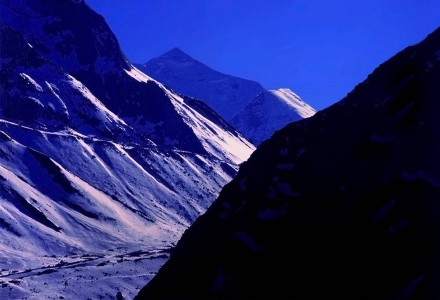
Bandar Poonch Range- Tapovan-Garhwal- Indian Himalayas. I had treked alone to Tapovan accompanied by two porters, who carried my equipment, tent & rations. It was a terribly exhausting trek via Bhojbasa and then walking across the extremely dangerous Gaumukh glacier. Being prone to altitude sickness it was all the more worse for me.
Text and photos by Madhur Dhingra.
This photo essay is a very personal journey of mine. The quest started very early in my childhood. I clearly remember buying my first book on Buddhist philosophy at the age of sixteen. This search has continued till date. I come from a family which has been fairly religious all through. In our house Aarti (A Hindu prayer ritual with butter lamps & devotional songs) was performed regularly both morning and evening by my grandfather. This practice was continued by my father all through his life.
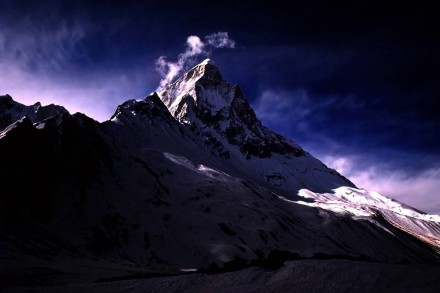
Dawn at Shivling Peak- Tapovan-Garhwal- Indian Himalayas. The first night en route to Tapvan I stayed at the Lal Baba ashram at Gaumukh. I was provided with meals and hot refreshing tea by the ashram authorities free of cost. The conditions were very severe and night temperatures went down to -6 To - 8 degrees with snow all around. I had reached early, in the first week of April, the snows had not melted yet. In this image one can easily see the knee deep snow conditions at Tapovan. Shiving Parbat is a photographer's delight and one gets to view this peak right from the base to the very top from Tapovan.
I have never been religious in the orthodox sense. My search has always been more spiritual in nature. The medium through which I began my quest was a camera. I must state here that I have always equated light with God. I am of firm conviction that the darkness of the human soul, (represented as black in my images) finally becomes alive by the play of light (God) on it. This play of light and shade you will notice all through in this photo essay.

Zanskar- Ladakh-India. This image was taken while travelling somewhere in the Zanskar region. The sun had set and evening winds were blowing strong, bellowing and raising the sand as they blew along. I saw this old Buddhist monk returning home with his yak in tow. One of my favourite images this one because somehow relate myself to the intense loneliness in this image.
Initially I started wandering in the Himalayas. This wandering first took me to places like Tapovan and Nandanvan in the Gangotri region of Garhwal. Camera in hand I saw God standing right in front of me in the form of these beautiful mountains. The play of light on this majestic abode of Shiva (Lord of Creation & Destruction) was an ethereal sight.
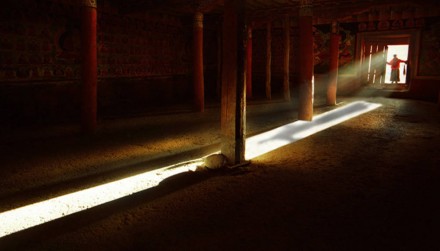
Somewhere in Leh- Ladakh - India. This image was shot by me inside an unnamed monastery in Ladakh. Many of these monasteries are centuries old. There is a beautiful calm prevailing inside them. I used to sit inside them for hours, watching light filter in through doors and windows. The occasional eco of the prayer gong would seep deep inside my soul.
My wanderings now took me to Ladakh & Zanskar regions again in the Indian Himalayas and also the land of Dalai Lama. I was mesmerised by the landscape, monasteries and people of Ladakh. The quiet prevailing inside these monasteries which are centuries old, acted as balm on my taught nerves. Light filtering in from the windows and doors was indeed beautiful. There was an embedded laziness prevailing in the atmosphere. Everyone and everything seemed so relaxed and poised. I would sit inside these monasteries for hours at a stretch soothing my distraught mind. I would watch quietly people go in and out of these temples. Occasionally someone would sound the prayer gong and its echo would seep deep inside my soul. Through my images I have tried to bring back to you the beauty, serenity and peace I found there.
My next visits were to Banaras (also known Varanasi or by the ancient name of Kashi). Now this was going to be an experience that will remain with me for the rest of my life. Banaras is one of the oldest living cities of the world. Mark Twain the English author once wrote” Banaras is older than history, older than tradition, even older than legend and looks twice as old as all of them put together”. I would get up very early in the morning much before daybreak and go and sit on the banks of Dashashwamedh Ghat. Activities on these ghats would start that early too. Sitting there I watched sadhus, pujaris, devotes, pilgrims take their morning dip in the river Ganga. The morning Arti reminded me over and again of the Aarti that my grandfather and father used to perform at our home. Those fading memories suddenly had become alive.
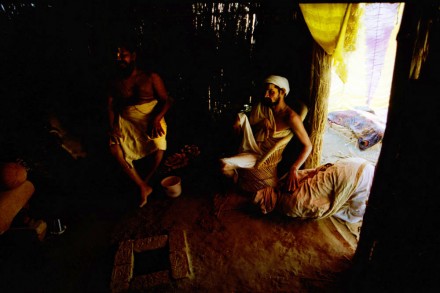
Haridwar - Uttara Khund- India. The year 1998 brought about Purn Kumbh the largest of all Hindu congregations. The word Kumbh denotes the shape like that of a pot or pitcher. Kumbh signifies Creation or Shrishti. ‘Shrishti’ or the creation is of the shape of a pot. Kumbh or Creation is eternal, the form may have been different before. there were hutments built for sadhus in general by the kumbh authorities across the river bed. I would visit those and sit with some "real" sanyasis , listen to their discourses and hear them sing bhajans(devotional songs). this was a very nice and peaceful experience.
The ghats of Kashi are a riot of colour and activity. People from all over India come to these ghats to perform rituals, in such colourful attires. On the other hand I saw sadhus, sanyasis, pujaris and widows dressed in spotless pure white clothings. This mixture of colour and pure white in their attires was enchanting. Small temples can be seen in hundreds all along these ghats. I would sit inside these temples waiting for my chance to get my perfect shot. Nowhere in all my travels up till now have I found light as beautiful as in Banaras. I will not hesitate for a moment to call it divine. Rituals right from the birth of a child, mundan (first hair removal ceremony of a newborn), marriage, birthdays, anniversary death, and also later to perform rites for their safe passage to heaven, all are being performed on these very banks for centuries.
In the meantime the Purn Kumbh (the largest Hindu congregation held every 12 years) was on at Haridwar. This again has become a very interesting event to relate. I was aghast to see the completely naked so called Naga sadhus, storming the streets of Haridwar. It was here I came to know from the local inhabitants of Haridwar that this whole show was a complete farce. Most of these so called ascetics only stormed the streets during the Kumbh and neither did they live in the remoteness of the Himalayas leading a renounced life. On the contrary they lived in air conditioned lavishly furnished Akharas (Akhara means literally the “place for practice for the protection of Hindu religion”) in Haridwar itself. They were a weird sight. Here in Haridwar I saw them fight pitched battles with the police a day before the main procession was to start. Downright criminals to the very core most of them.
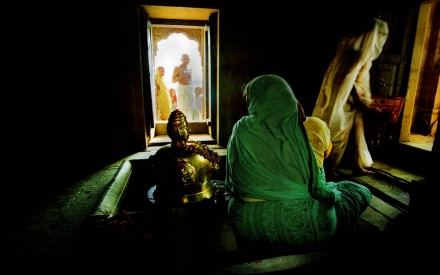
Dashashwamedh Ghat-Varanasi (Banaras)-India. This beautiful image I captured on one of the ghats of banaras. i would get up early in the morning and go and sit inside these small temples spread in hundreds all along the ghats .people would come and go, oblivious of me sitting in one dark corner with a camera.
On the day of the main procession I got up early in the morning and positioned myself on the roof top of a house near the Niranjani Akhara(Niranjani is one of the prominent Akharas in Haridwar). This was very early in the morning and I was testing the auto focus of my telephoto 300mm canon lens when I saw a group of Nagas in gathered in the Akhara compound. I was taken aback when I saw one Naga fiddling with the genitals of the other Naga, “and I took the shot” (later to appear on the first page of the Indian Express Daily). Promiscuity is commonplace with these so called Naga sadhus.
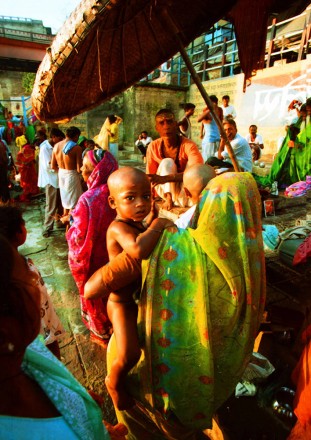
Dashashwamedh Ghat-Varanasi (Banaras)-India. The ghats of Kashi are a riot of colour and activity. People from all over India come to these ghats to perform rituals, in such colourful attires.Rituals right from the birth of a child, mundan (first hair removal ceremony of a newborn), marriage, birthdays, anniversary death, and also later to perform rites for their safe passage to heaven, all are being performed on these very banks for centuries.
There were hutments built for all visiting sadhus in general by the Kumbh authorities across the river bed of the Ganges. I would visit those and sit with some real sanyasis, listen to their discourses and hear them sing Bhajans (devotional songs). This was a very nice and spiritual experience.
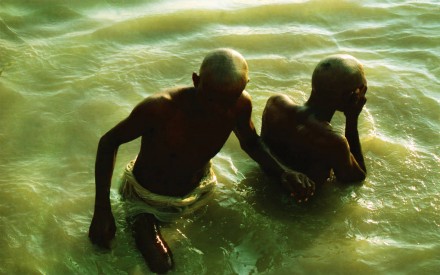
Dashashwamedh Ghat-Varanasi (Banaras)-India. These two brothers had come to the dashashvamedh ghat after performing the final rites of their father at manikarnika ghat. it is believed by the hindus that a dip in the ganga purifies them of all sins committed during their passage of life.
Now a special reference to the Manikarnika Ghat “The Burning Ghat”is needed. People from all over India come to Kashi (ancient name of Banaras) to cremate their dead at Manikarnika. It is believed by Hindus that a cremation at Manikarnika Ghat gives the human soul an unhindered passage to heaven. Pyres are being lit here continuously without getting extinguished for the last 3000 years. But it was on this burning Ghat that my worst nightmare was to begin. I would visit this Ghat daily looking at the activities. It was not very long before I realised that whenever a body of a poor person would come in, it would be cremated in a bizarre manner.
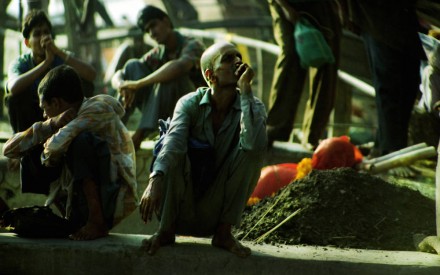
Manikarnika Ghat-Varanasi (Banaras)-India. People from all over India come to Kashi (ancient name of Banaras) to cremate their dead at Manikarnika. It is believed by Hindus that a cremation at Manikarnika Ghat gives the human soul an unhindered passage to heaven. Pyres are being lit here continuously without getting extinguished for the last 3000 years. This image shows the continuous gloom prevailing over Manikarnika Ghat.
It required two ‘muns’ of wood at the least (mun is an Indian measure of weight equivalent to 20 kgs) to cover a human body completely for cremation. But the persons accompanying the dead body did not have that much money in their pocket. So only that much wood was purchased in which only the torso could be covered by wood. The legs and head were left hanging out and the pyre lit. The head would get burnt in a horrific manner with the head and feet falling away from the torso partially burnt. Then these torn away parts were picked up and put into the pyre or thrown into the Ganges. It was literally making a bar-be-queue of the mortal remains . This whole sequence was so bizarre that I decided to get it on film and show it to the world. Man really was meeting his god in Kashi in a very bizarre manner. Tantriks (Aghoris) also hound this Ghat eating human flesh and making love to a dead woman on a full moon night.
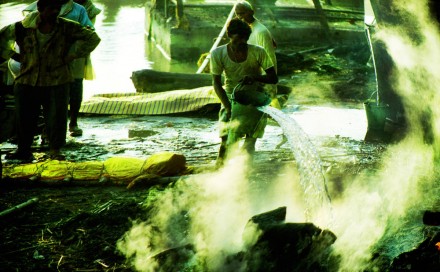
Manikarnika Ghat-Varanasi (Banaras)-India. The beautiful morning light of Banaras is equally kind to both living and dead. I visited the manikarnika ghat one early morning to find it more busy than usual. The light filtering in from the rising smoke and ashes was both beautiful and eerie.
One interesting image I shot here is of some dogs copulating right on where the pyres were being burnt. I saw the eyes of the people more interested in watching the dogs copulating and found them giggling, whereas right in front of them burnt the pyre of somebody very close to them. Hedonism co-existed strongly amidst death.
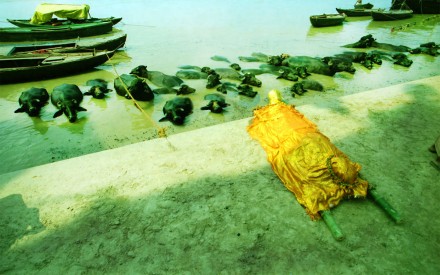
Manikarnika Ghat-Varanasi (Banaras)-India. This was a chance image while I roamed around the Manikarnika. According to Hindu tradition, people who die under unnatural conditions like a snake bite or accidents, sanyasis & infants, their bodies are not burnt but are given a water burial .I saw this lonely body on the banks of Ganga with nobody visible in sight. A herd of buffalos had gathered all around it as if waiting to take the body away. Incidently the vahan (vehicle) of Yamraj (Lord of Death ) is a buffalo.
My final image is of a lonesome skull lying amidst blue burnt wood and ashes, staring right into the eyes of the onlooker, as if asking some unanswered questions. All hopes ambitions fears loves hates affections had died down into a cold blue colour. “Man had finally met his god”?
For more photos and story please visit Madhur Dhingra website.
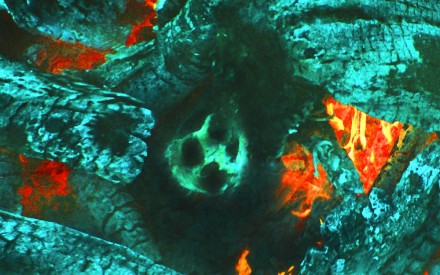
Manikarnika Ghat-Varanasi (Banaras)-India. This final image is of a lonesome skull lying amidst blue burnt wood and ashes, staring right into the eyes of the onlooker, as if asking some unanswered questions. all hopes ambitions fears loves hates affections had died down into a cold blue colour.

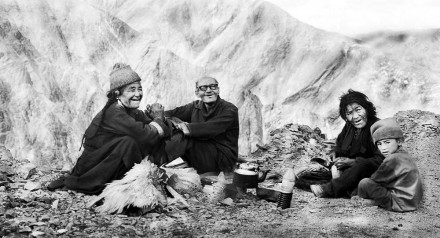
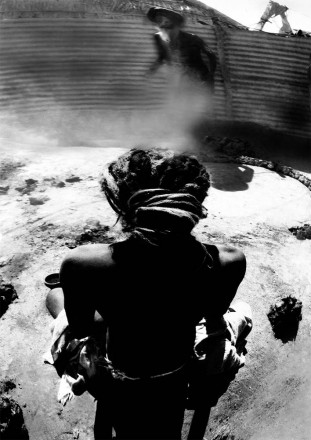
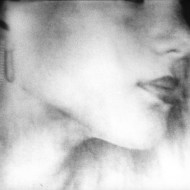

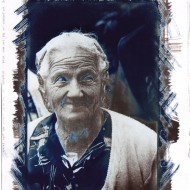






























Nice article sir…both the write up complements with your pictures and experiences shared. I too wish to do the Gaumukh trek since long. This articles recreated my hunger for such treks and solo soul searching journey… 🙂
Regards,
Rishi Gajbhiye
You can also subscribe to this post comments RSS feed.